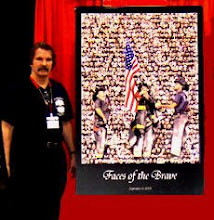Firefighters in focus at 9/11 Exhibit
Saturday, September 03, 2005
BY MITCHELL SEIDELStar-Ledger Staff
Gary Marlon Suson has seen things most of us would rather forget. He prefers that we remember them.
Suson is the creator of the Ground Zero Museum Workshop in the New York meatpacking district, a collection of photographs and artifacts from his time as a photographer during the cleanup at Ground Zero. Acting with the blessing of a former trustee of the Uniformed Firefighters Association, the city's largest firefighters' union, Suson was able to get as close to recovery operations after the Sept. 11, 2001 terrorist attacks as one could without being a member of the fire department. This afforded him the opportunity to get intimate shots of firefighters searching for the bodies of their comrades.
The images range from the day- to-day digging operations, like some open pit mine, to the hidden and sometimes oddly preserved scenes found underneath the rubble.
A black and white shot shows bricks and crushed ceiling tiles scattered in front of the turnstiles of the World Trade Center's PATH station, the ceiling appearing to have come down like the roof of a cave. The contrast between what we remember from the intact structure and what Suson's image shows is striking.
Buildings and beams loom over the damaged hull of PATH car #143, unearthed to the open air yet still buried in rubble up to floor level. The shot, taken at night, was printed in sepia, as are most of the black and white shots in the show. The toning helps to take some of what could have been an antiseptic feel away from images that could just as easily been rendered in cold- tone black and white.
Another sepia-toned image shows three older men in fire department rescue gear sitting on a small all-terrain vehicle or "gator" in the mud of the Ground Zero pit. Their part in the recovery process is that of bereaved fathers looking for the remains of their own sons. Their appearance is a combination of emotional and physical fatigue as they take the ride to join the honor guard during the removal of yet another firefighter's remains.
Some of Suson's color photographs are transformed into layered constructions. In one, the central silhouette of a fire department chaplain, back to camera, is separated from the main image along with a firefighter at right and several pieces of debris pulled out of the photo. At the base of the image is a Plexiglas planter-like box filled with rubble. This three-dimensional effect takes the imagery beyond simple photography.
Suson, 33, has said the proceeds of ticket sales to his permanent exhibit will go to six 9/11-related charities. He has been criticized for displaying recovered Ground Zero objects with his photographs. Current administrators of the firefighters' union have taken issue with Suson's portrayal of himself as the union's "official" photographer. However, anyone familiar with the recovery operation has to acknowledge Suson had someone's permission to be that close.
Suson contends he had official permission to remove the objects on display with the photos, including a partial Windows on the World restaurant invoice, a crushed cell phone and a teddy bear.
New York City Mayor Michael Bloomberg on Thursday denounced Suson's project as exploitative, and firefighters' union officials reportedly said they opposed the display of personal items from Ground Zero.
"You're witnessing what happens when evil people try to destroy something in the name of helping," Suson said of his critics.
Mitchell Seidel writes about photography for The Star-Ledger. He can be reached at (973) 392-1780 or msei del@starledger.com.

